Experimental Study on the Charge Signal Time-Frequency Characteristics during Fracture Process of Precracked Syenogranite under Uniaxial Compression
Abstract
1. Introduction
2. Experimental Procedure
2.1. Specimen Preparation
2.2. Experimental System
3. Analyses of Experimental Results
3.1. Mechanical Characteristics for Syenogranite Exhibiting Varying Inclination Cracks
3.2. Charge-Induction Signal Variation Laws
3.3. Charge-Induction Signal Characteristics
3.3.1. Time Domain Characteristics
3.3.2. Frequency-Domain Characteristics
3.3.3. Domain of Time-Frequency Characteristics
3.4. Comprehensive Analysis
4. Discussion
5. Summary
- (1)
- The influence of crack on the strength of syenogranite is significant. The uniaxial compression strength of specimens with a crack is greatly reduced, and the strain at failure is also significantly reduced. The uniaxial compression strength of syenogranite decreases linearly with the increase of crack inclination;
- (2)
- Signals caused by charge induction that were produced in the deformation as well as fracture of intact syenogranite are more abundant than those of crack syenogranite, and the number of charge-induction signal events is more. The signal amplitude during charge induction and the correlation between the signals are different in every phase of the deformation and fracture process of syenogranite, and the influence of the crack inclination on the amplitude and the correlation is also different;
- (3)
- The location of the charge-induction signal produced by the distortion, as well as the fracture process, of syenogranite has a certain correlation with the crack inclination. Around the crack, the charge-induction signal events with high energy are numerous, and the amplitude is relatively large along the crack inclination direction;
- (4)
- In the phase of rack propagation, there are large-amplitude, medium-correlation, and even high-correlation signals associated with charge induction, which can give an early warning of the deformation failure of the syenogranite. In the instability-failure phase, when the large-amplitude and high-correlation signals associated with charge induction are generated, it means that the syenogranite has entered the instability-failure phase and has a high risk;
- (5)
- From the elastic linear-deformation phase to the instability-failure phase, the amplitude and power values of the signals associated with charge induction gradually increase in every frequency band and reach the maximum value in the instability-failure phase. In the instability-failure phase, the charge-induction signal frequency band is distributed in 0–400 Hz, which is different from the other two phases, and the main frequencies are 10–15 Hz. With the increase of the crack inclination, the power of the charge-induction signal increases.
Author Contributions
Funding
Data Availability Statement
Acknowledgments
Conflicts of Interest
References
- Pan, Y.S.; Wang, L.G.; Zhang, M.T. Theoretical and experimental study on the occurrence of fault rockburst. Chin. J. Rock Mech. Eng. 1998, 17, 642–649. [Google Scholar]
- Zhao, Y.F.; Pan, Y.S.; Yu, H.J. Analysis of fault rockburst based on shear beam model for interface failure. Rock Soil Mech. 2007, 28, 1571–1576. [Google Scholar]
- Huang, L.C.; Ma, J.J.; Lei, M.F. Soil-water inrush induced shield tunnel lining damage and its stabilization: A case study. Tunn. Undergr. Space Technol. 2020, 97, 103290. [Google Scholar] [CrossRef]
- Ma, J.J.; Chen, J.J.; Guan, J.W. Implementation of Johnson-Holmquist-Beissel model in four-dimensional lattice spring model and its application in projectile penetration. Int. J. Impact Eng. 2022, 170, 104340. [Google Scholar] [CrossRef]
- Kuksenko, V.S.; Makhmudov, K.F. Mechanically-induced electrical effects in natural dielectrics. Tech. Phys. Lett. 1997, 23, 126–127. [Google Scholar] [CrossRef]
- Kuksenko, V.S.; Makhmudov, K.h.F.; Ponomarev, A.V. Relaxation of electric fields induced by mechanical loading in natural dielectrics. Phys. Solid State 1997, 39, 1065–1066. [Google Scholar] [CrossRef]
- Guo, Z.Q.; Zhou, D.Z.; Shi, X.J. Electron emission during rock fracture. Chin. J. Geophys. 1988, 31, 566–571. [Google Scholar]
- Guo, Z.Q.; Liu, B. Frequency properties of electromagnetic emission associated with microscopic cracking in rocks. Chin. J. Geophys. 1995, 38, 221–226. [Google Scholar]
- Sun, Z.J.; Wang, L.H.; Gao, H. Electromagnetic emission and light radiation during fracture of rock samples. Chin. J. Geophys. 1986, 29, 491–495. [Google Scholar]
- Zhu, Y.Q.; Guo, X.L.; Guo, Z.Q. A study of mechanism on electromagnetic emission associated with rock fracture. Chin. J. Geophys. 1991, 34, 594–601. [Google Scholar]
- Wu, X.P.; Shi, X.J.; Guo, Z.Q. Study of the electrification of granite samples under compression. Chin. J. Geophys. 1990, 33, 208–211. [Google Scholar]
- Hao, J.Q.; Liu, L.Q.; Long, H.L. New result of the experiment on self-potential change of rocks under biaxial compression. Chin. J. Geophys. 2004, 47, 475–482. [Google Scholar] [CrossRef]
- Hao, J.Q.; Qian, S.Q.; Gao, J.T. ULF electric and magnetic anomalies accompanying the cracking of rock sample. Acta Seismol. Sin. 2003, 25, 102–111. [Google Scholar] [CrossRef]
- Zhao, Y.F.; Pan, Y.S.; Li, G.Z. Measuring of the charge-induced signal of rock during the deformation and fracture process. J. Disaster Prev. Mitig. Eng. 2010, 30, 252–256. [Google Scholar]
- Zhao, Y.F.; Pan, Y.S.; Liu, Y.C. Experimental study of charge induction of coal samples under uniaxial compression. Chin. J. Rock Mech. Eng. 2011, 30, 306–312. [Google Scholar]
- Pan, Y.S.; Zhao, Y.F.; Li, G.Z. Charge-induced technique of predicting rock burst and its application. Chin. J. Rock Mech. Eng. 2012, 31, 3988–3993. [Google Scholar]
- Pan, Y.S.; Tang, Z.; Li, Z.H. Research on the charge inducing regularity of coal rock at different loading rate in uniaxial compression tests. Chin. J. Geophys. 2013, 56, 1043–1048. [Google Scholar]
- Pan, Y.S.; Tang, Z.; Xiao, X.C. Experimental study on mechanical-charge induction law of coal containing gas under triaxial compression. J. China Coal Soc. 2012, 37, 918–922. [Google Scholar]
- Pan, Y.S.; Tang, Z.; Luo, H. Study of charge induction law of coal and rock mass during tensile instability and failure. Chin. J. Rock Mech. Eng. 2013, 32, 1297–1303. [Google Scholar]
- Pan, Y.S.; Zhao, Y.F.; Luo, H. Application of charge induction monitoring technology of mine dynamic disaster. Coal Sci. Technol. 2013, 41, 29–34. [Google Scholar]
- Yang, Y.L.; Li, Z.H.; Wang, E.Y. Experiment study on surface potential characteristics and rules during coal or rock friction process. J. China Coal Soc. 2013, 38, 215–220. [Google Scholar]
- Liu, Y.J.; Li, Z.H.; Song, D.Z. Experimental research on surface potential induced by gas sorption process in coal. J. China Coal Soc. 2013, 38, 1977–1981. [Google Scholar]
- Kong, Y.H.; Li, Z.H.; Qiu, L.M. Research on variation rule of coal rock during water-inrush process. J. Mine Autom. 2017, 46, 38–42. [Google Scholar]
- Zhang, X.H.; Li, Z.H.; Niu, Y. Experimental study on electric potential critical slowing down characteristics before unstable failure of roof rocks. J. Mine Autom. 2018, 44, 26–31. [Google Scholar]
- Liu, J.; Wang, E.Y.; Li, Z.H. Experimental study on surface potential of pre-cracked coal under uniaxial compression. J. China Coal Soc. 2011, 36, 1135–1138. [Google Scholar]
- Ren, X.K.; Wang, E.Y.; Li, Z.H. Experimental study of characteristics of surface potential and electromagnetic radiation of pre-cracked rock plate during fracture. J. China Univ. Min. Technol. 2016, 45, 440–446. [Google Scholar]
- Wang, G.; Pan, Y.S.; Xiao, X.C. Detection of effects of rock burst prevention by water injection into coal seam using charge induction method. Chin. J. Geotech. Eng. 2019, 41, 311–319. [Google Scholar]
- Wang, G.; Pan, Y.S.; Xiao, X.C. Experimental study on the failure characteristics and charge law of coal samples with large scale single pre-crack. J. China Coal Soc. 2018, 43, 2187–2195. [Google Scholar]
- Xiao, X.C.; Pan, Y.S.; Ding, X. Experiment of acoustic emission and charge induction in granular coal rock failure. J. China Coal Soc. 2015, 40, 1796–1804. [Google Scholar]
- Feng, G.; Wang, X.C.; Wang, M. Experimental investigation of thermal cycling on fracture characteristics of granite in a geothermal-energy reservoir. Eng. Fract. Mech. 2020, 235, 107180. [Google Scholar] [CrossRef]
- Feng, G.; Wang, X.C.; Kang, Y. Effect of thermal cycling-dependent cracks on physical and mechanical properties of granite for enhanced geothermal system. Int. J. Rock Mech. Min. Sci. 2020, 134, 104476. [Google Scholar] [CrossRef]
- Feng, G.; Zhu, C.; Wang, X.C. Thermal effects on prediction accuracy of dense granite mechanical behaviors using modified maximum tangential stress criterion. J. Rock Mech. Geotech. Eng. 2023, in press. [CrossRef]
- Ma, J.J.; Chen, J.J.; Chen, W.X. A coupled thermal-elastic-plastic-damage model for concrete subjected to dynamic loading. Int. J. Plast. 2022, 153, 103279. [Google Scholar] [CrossRef]
- Luo, H.; Pan, Y.S.; Yu, J.K. Electric charge induction law of coal rock containing gas with bursting tendency during loading failure process. J. China Coal Soc. 2020, 45, 684–694. [Google Scholar]
- Zhao, Y.F.; Jing, G.; Li, B. Charge signal time-frequency characteristics of granite under uniaxial compression. Coal Sci. Technol. 2021, 49, 47–53. [Google Scholar]
- Zhao, Y.F.; Jing, G.; Li, B. Tests for fracture characteristics of fractured sandstone and microseismic and charge induced signal laws. J. Vib. Shock 2020, 39, 211–219+233. [Google Scholar]
- Zhao, Y.F.; Jing, G.; Fan, Y. Experimental study on the microseism and charge signal time-frequency characteristics in the process of fault stick-slip instability. Chin. J. Rock Mech. Eng. 2020, 39, 1385–1395. [Google Scholar]
- Li, D.X.; Wang, E.Y.; Yue, J.H. A weak current technique for coal and rock dynamic disaster prediction and its application. Chin. J. Rock Mech. Eng. 2022, 41, 764–774. [Google Scholar]
- Li, F.H.; Ren, H.F.; Wang, J.Q. An Overview of Fault Rockburst in Coal Mines. IOP Conf. Ser. Earth Environ. Sci. 2018, 199, 052039. [Google Scholar] [CrossRef]
- Cheng, T.; He, M.C.; Li, H.R. Experimental investigation on the influence of a single structural plane on rockburst. Tunn. Undergr. Space Technol. Inc. Trenchless Technol. Res. 2023, 132, 104914. [Google Scholar] [CrossRef]
- Dou, L.M.; Mu, Z.L.; Li, Z.L. Research progress of monitoring, forecasting, and prevention of rockburst in underground coal mining in China. Int. J. Coal Sci. Technol. 2014, 1, 278–288. [Google Scholar] [CrossRef]
- Pamnani, G.; Bhattacharya, S.; Sanyal, S. Analysis of interface crack in piezoelectric materials using extended finite element method. Mech. Adv. Mater. Struct. 2019, 26, 1447–1457. [Google Scholar] [CrossRef]
- Pamnani, G.; Bhattacharya, S.; Sanyal, S. Analysis of semipermeable crack growth in piezoelectric materials using extended finite element method. Int. J. Appl. Mech. 2017, 9, 1750106. [Google Scholar] [CrossRef]
- Yue, Y.; Wan, Y. Parametric design of multilayered piezoelectric/piezomagnetic transducers with periodic interfacial electrodes based on fracture mechanics analysis. Mech. Adv. Mater. Struct. 2020, 28, 2131–2140. [Google Scholar] [CrossRef]
- Soletta, J.; Farfan, F.; Felice, C. Measuring Spike Train Correlation with Non-Parametric Statistics Coefficient. IEEE Lat. Am. Trans. 2016, 13, 3743–3746. [Google Scholar] [CrossRef]
- Huang, N.E.; Shen, Z.; Long, S.R. The empirical mode decomposition and the Hilbert spectrum for nonlinear and non-stationary time series analysis. Proc. A 1998, 454, 903–995. [Google Scholar] [CrossRef]
- Xiao, X.C.; Ding, X.; Lu, X.F. Investigation on charge signal time-frequency domain characteristics in coal failure process and noise reduction. J. China Coal Soc. 2018, 43, 657–666. [Google Scholar]
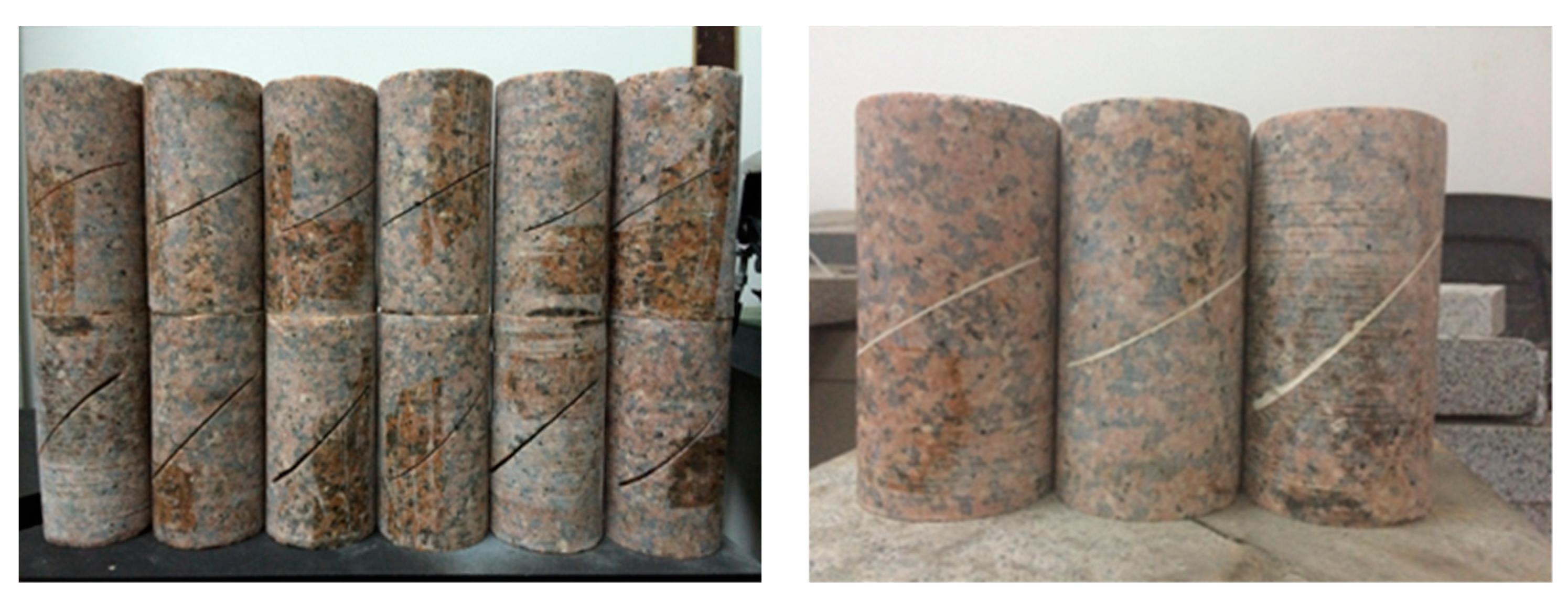

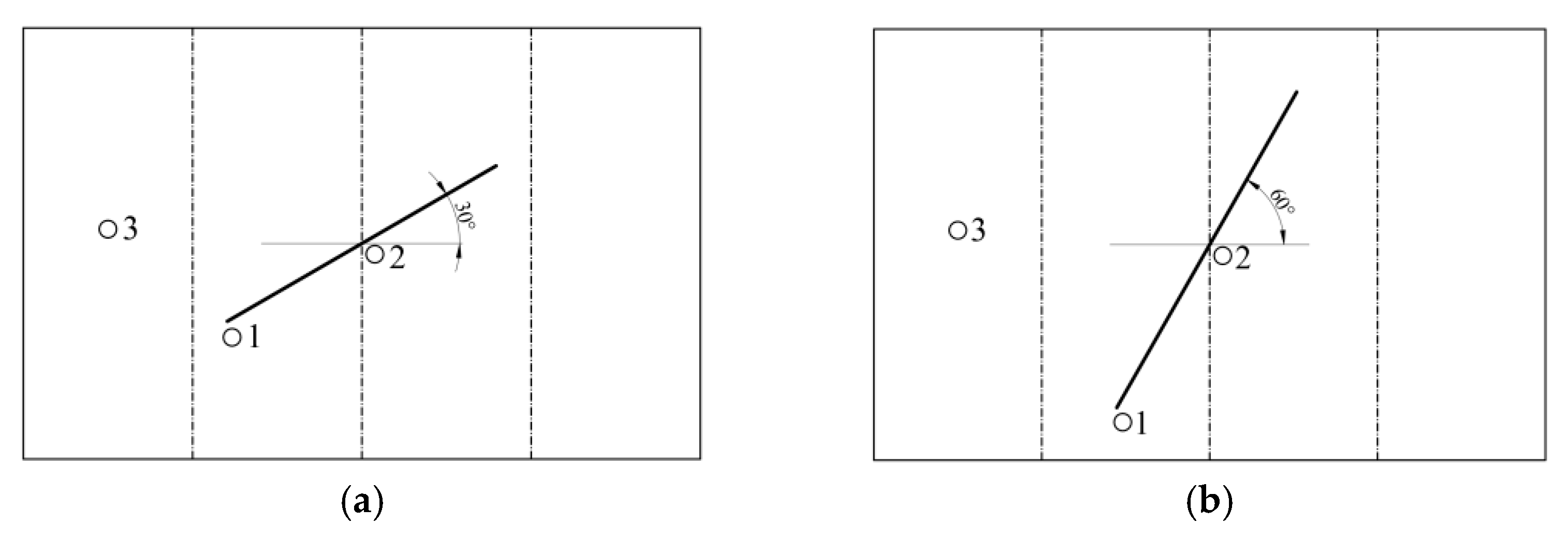
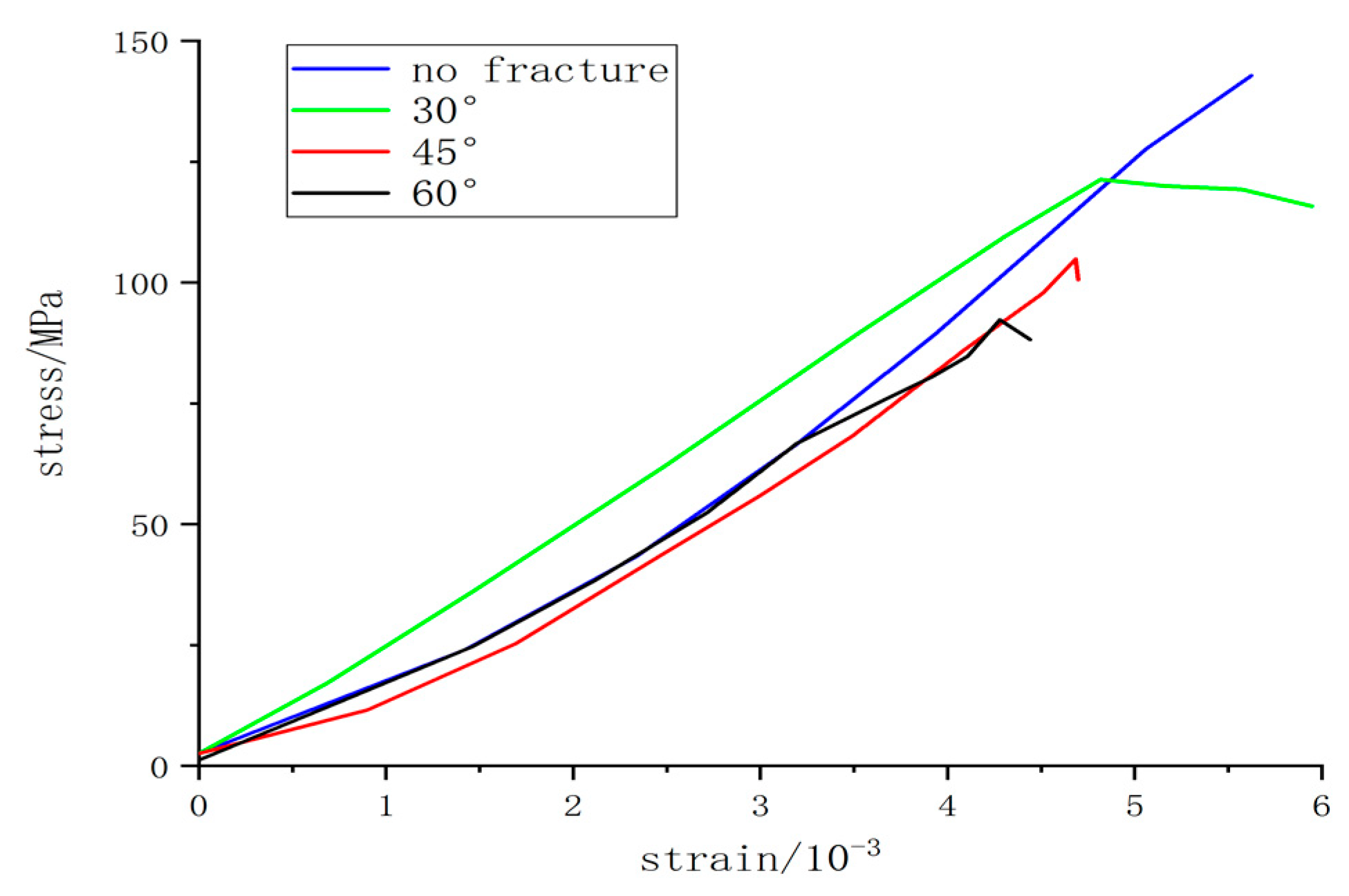

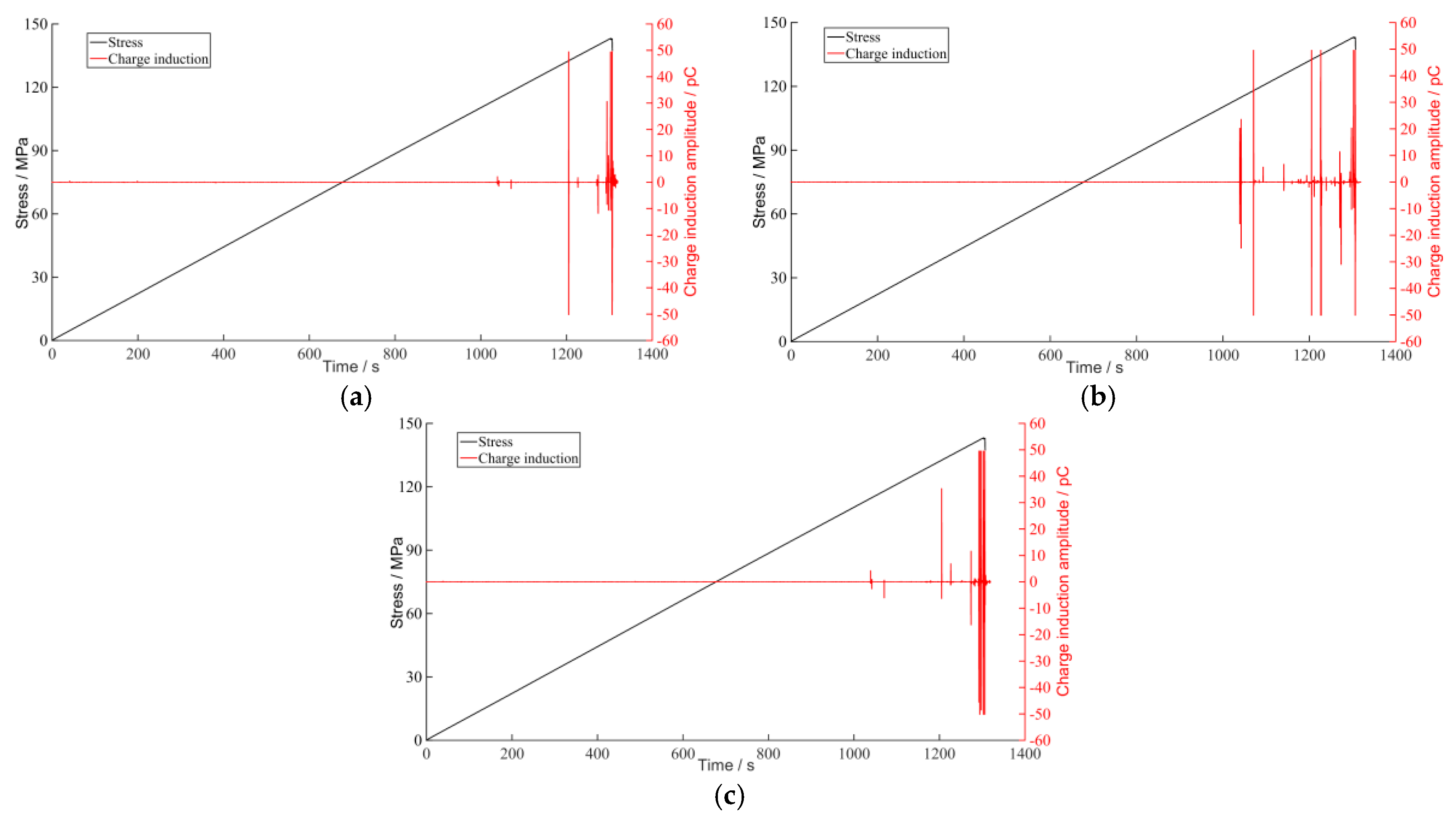


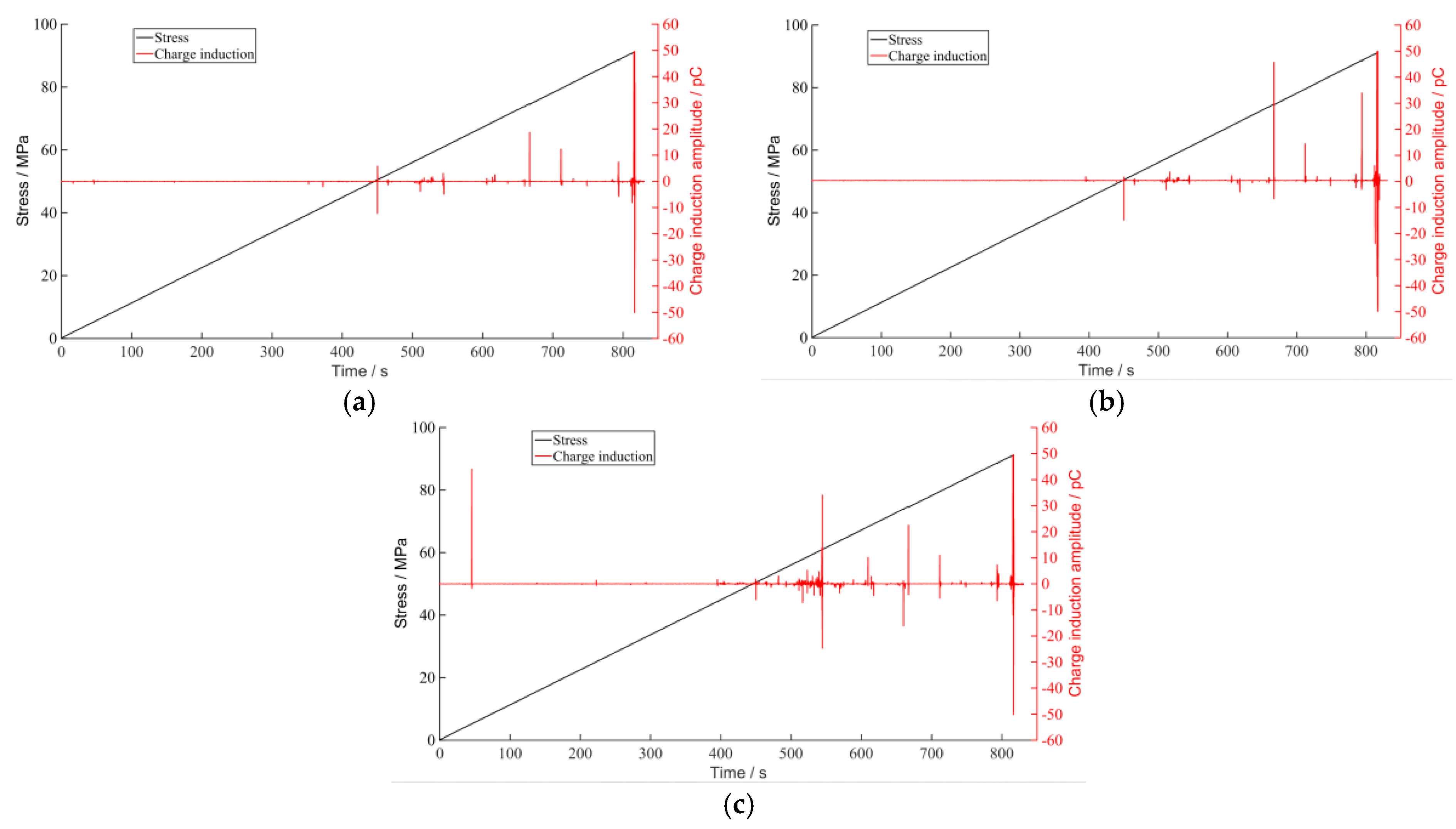




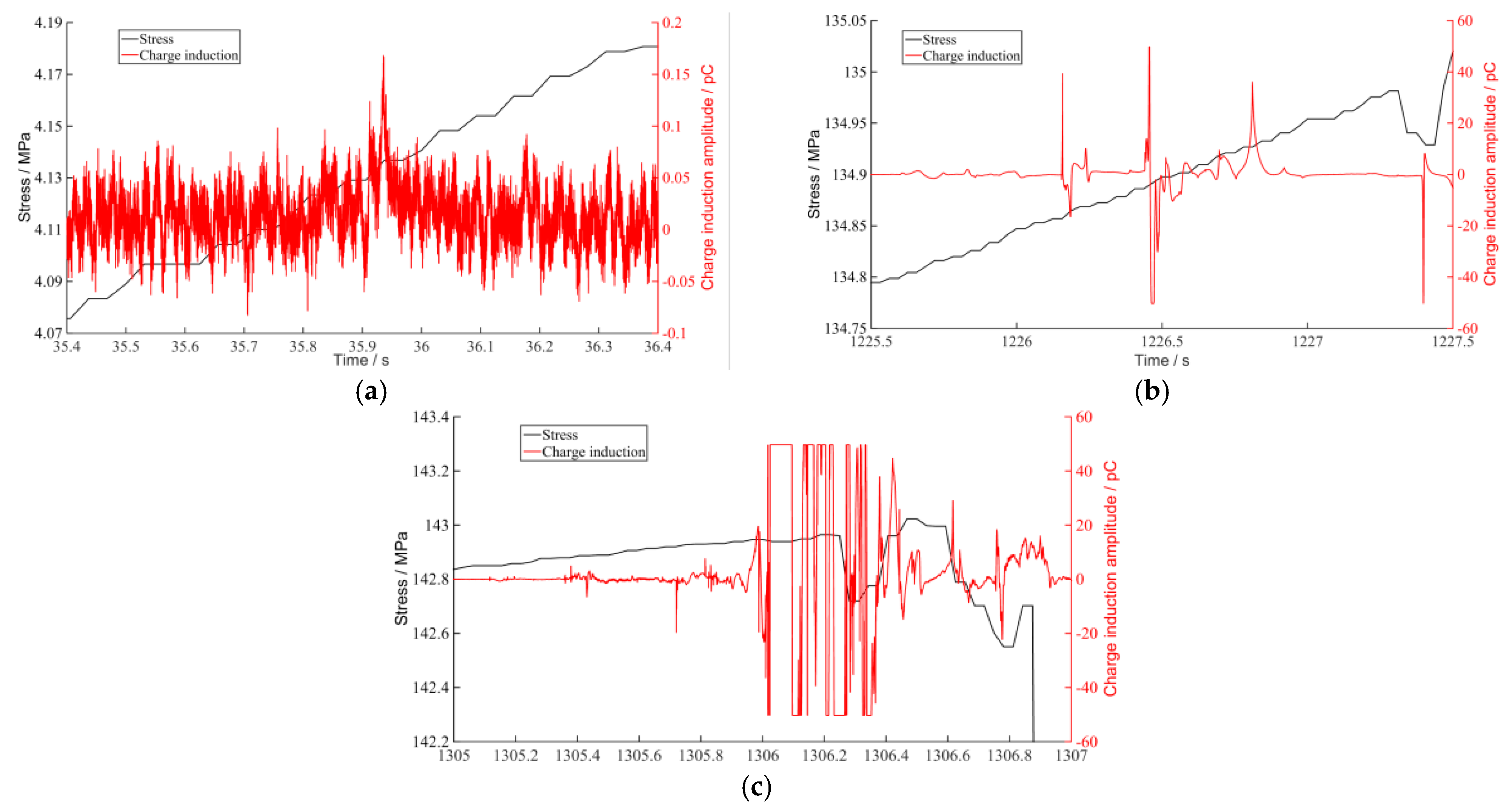
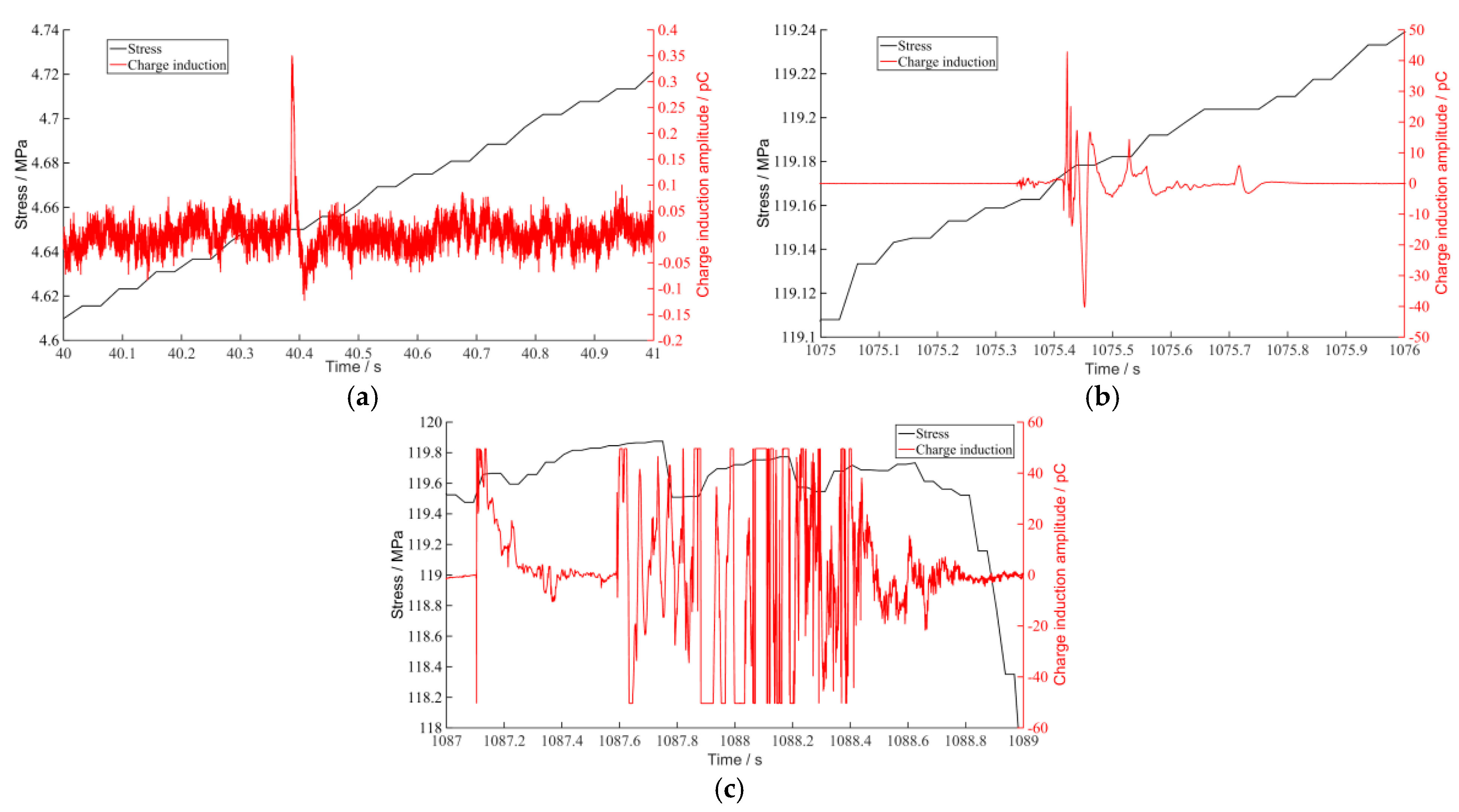


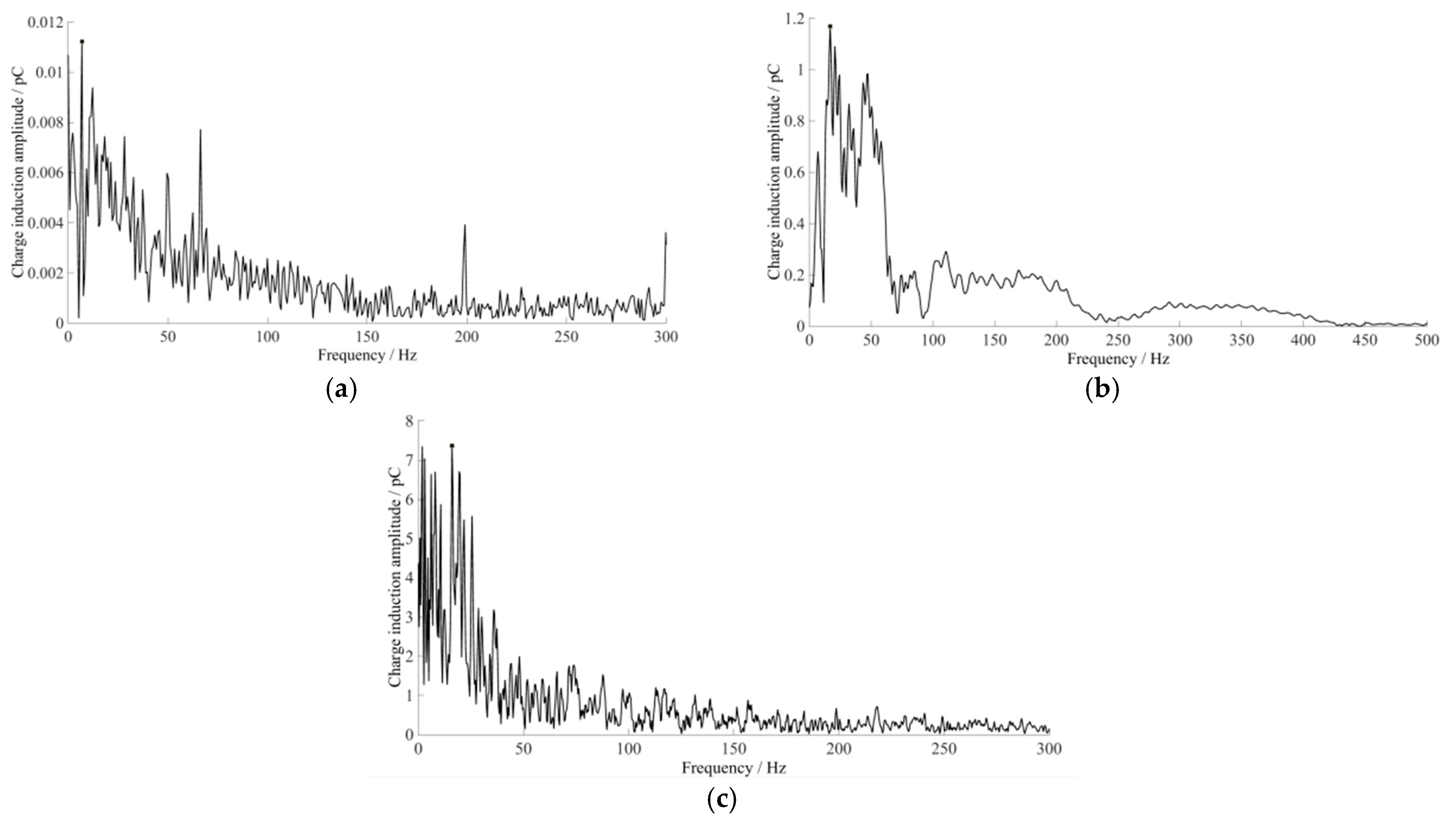




Disclaimer/Publisher’s Note: The statements, opinions and data contained in all publications are solely those of the individual author(s) and contributor(s) and not of MDPI and/or the editor(s). MDPI and/or the editor(s) disclaim responsibility for any injury to people or property resulting from any ideas, methods, instructions or products referred to in the content. |
© 2023 by the authors. Licensee MDPI, Basel, Switzerland. This article is an open access article distributed under the terms and conditions of the Creative Commons Attribution (CC BY) license (https://creativecommons.org/licenses/by/4.0/).
Share and Cite
Liu, Y.; Ding, L.; Zhao, Y. Experimental Study on the Charge Signal Time-Frequency Characteristics during Fracture Process of Precracked Syenogranite under Uniaxial Compression. Sustainability 2023, 15, 9482. https://doi.org/10.3390/su15129482
Liu Y, Ding L, Zhao Y. Experimental Study on the Charge Signal Time-Frequency Characteristics during Fracture Process of Precracked Syenogranite under Uniaxial Compression. Sustainability. 2023; 15(12):9482. https://doi.org/10.3390/su15129482
Chicago/Turabian StyleLiu, Yuchun, Ling Ding, and Yangfeng Zhao. 2023. "Experimental Study on the Charge Signal Time-Frequency Characteristics during Fracture Process of Precracked Syenogranite under Uniaxial Compression" Sustainability 15, no. 12: 9482. https://doi.org/10.3390/su15129482
APA StyleLiu, Y., Ding, L., & Zhao, Y. (2023). Experimental Study on the Charge Signal Time-Frequency Characteristics during Fracture Process of Precracked Syenogranite under Uniaxial Compression. Sustainability, 15(12), 9482. https://doi.org/10.3390/su15129482





